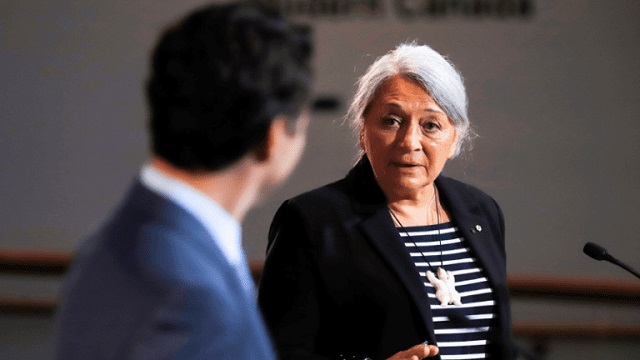MacDonald Laurier Institute
The (one hundred) million dollar question – What is a journalist?: Peter Menzies

From the MacDonald Laurier Institute
By Peter Menzies
What the reaction to David Menzies’ arrest tells us about the profession in Canada
The best part about the RCMP’s recent street mugging of David (aka the Menzoid) Menzies was neither the uproar over the arrest nor the boost it provided to Rebel News’ bottom line.
Nope. The really giggly, wincey, cringeworthy part was the huffy offence taken by so many in the legacy media after Menzies was referred to as one of them—a journalist—and by no less an influencer than the leader of His Majesty’s Loyal Opposition.
“We’re going to stop arresting journalists,” said Conservative Leader Pierre Poilievre, referring to L’affaire Menzoid. “It’s outrageous for the prime minister and his government to have journalists arrested merely for asking questions of ministers and public officials.”
Thus was the cat thrown among the pigeons. Boy, did they flutter.
Globe and Mail columnist Shannon Proudfoot described Rebel News’ (standard) response to the matter—a fundraiser—as having more in common with “busking” than journalism.
CBC and its, at times, pompous panels referred to Menzies (no relation) as either a Rebel News “employee” or “personality,” as did Global News. National Post called him a “commentator.” One CBC reference to Menzies apparently presented him as someone who “self-identified” as a journalist, as if it was an orientation.
None of those are inaccurate. But all ensured no linkage between Menzies and the J-word, a metier to which media may assign a higher social rank than the one assumed by the public.
In case you missed it, Menzies was attempting to get a quote from Deputy Prime Minister Chrystia Freeland regarding the government’s hesitance to designate Iran’s Islamic Revolutionary Guard Corps as a terrorist organization. He approached her on the street in standard fashion and then her security officer set a pick which resulted in a mild collision of shoulders between himself and Menzies. The officer thuggishly pushed Menzies against a wall and arrested him for assault. The pride of Rebel News was then handcuffed and driven from the scene only to be quickly released without charge.
Many were outraged. But there was also a cohort that justified it all because Menzies, they said, is not a “real journalist.”
Some went so far as to suggest the formation of some sort of accreditation body to decide who should be deemed qualified to report on current affairs. None seemed to realize the government has already appointed one, albeit to determine who qualifies for its loot.
These displays of ill-informed hubris were not well-received by many independents practicing freedom of the press without government approval as qualified Canadian journalism organizations.
“Mainstream media is arrogant enough to define who is a journalist while their audience shrinks to nothing while alternative media like Rebel and Western Standard explode,” grumbled a former newspaper colleague now enjoying success as an unaligned online reporter. “Many journalists now working with so-called alternative media have way more experience in the industry than those working now in the dying mainstream.”
Let’s be clear: journalism is not a profession. Read it again. Journalism is not a profession.
It is a trade, or a craft, requiring no more than two semesters of post-secondary study followed by years of apprenticeship.
Yes, universities may have turned it into an over-priced paper chase but a quick look at most courses makes it clear a profound intellect is not a prerequisite.
The greatest skill traditionally required (and it is one often abandoned due to its difficulty) involves the ability to set aside one’s own biases, eschew all assumptions, and produce truly objective work that explores all sides of issues and events.
These days, though, not everyone subscribes to that, which means we have two very broad classes of news organizations.
One is composed of those who aspire to tell stories through the lens of objectivity. For them, the pursuit of journalism is an end in itself. It is also the practice in greatest alignment with what most reader surveys indicate is how the public wishes to be served. I call these people journalists because they toil thanklessly to reveal truths that challenge preconceptions and leave decisions concerning what to think about matters up to the reader/viewer/listener.
The other is best described as agenda journalism. Those involved in this far more romantic sphere tend to see journalism as the means towards an end, whether it be social justice, free markets, environmentalism, or Palestine—pick a cause and there’s a crusader at the ready, laptop and camera in hand.
I call these people storytellers. They certainly have their fans, many of whom believe them to be true journalists because they show them the world through a lens they find agreeable.
Within those categories—both of which contribute to the explosion of voices now available—there are a number of roles. The BBC website contains a comprehensive overview.
For instance, in print, “A reporter writes stories on a range of topics including news, politics, sports, culture and entertainment. Some are correspondents which means they specialize in a field, such as sport, health, crime, business or education. Others are feature writers who cover topics in more depth or write human-interest stories.”
While in broadcast, “A presenter is the voice (radio) or face (TV) of the show. He or she welcomes the audience to the show, interviews guests, reads news, shares information, reads off autocues, and prompts audience participation.”
This is so straightforward that, were it not for the fact Canada’s media are currently squabbling over who gets what funds provided by the government, it would be difficult to understand why it matters who gets to be called a journalist.
Herein lies the inherent challenge of government intervention in the news media. If the sector was left to market forces, then consumers would decide who and what constitutes journalism. But as soon as the government established its policy regime to support the sector, it needed to set parameters to determine eligibility. It needed, in other words, to put itself directly in the business of adjudicating who is a journalist. The Menzies episode (including the mainstream media reaction) demonstrates why this is such a bad idea.
Whether the entrenched players like it or not, surely a journalist is anyone with the capability and inclination to uncover and honestly distribute the news, information, and stories the public has a right to know.
Little wonder those begging loudest for seats in the financial lifeboats are the ones most desperate to declare their virtue and lay exclusive claim to the title.
Peter Menzies is a Senior Fellow with the Macdonald-Laurier Institute, a former newspaper executive, and past vice chair of the CRTC.
MacDonald Laurier Institute
The Governor General deserves better, but we deserve impartiality

From the Macdonald Laurier Institute
By Philippe Lagassé
Mary Simon’s impartiality was undermined by hosting a symposium tied to controversial government legislation.
Mary Simon has been a guarded Governor General. She’s adopted a low profile since her appointment, performing her vice-regal responsibilities without much notice. When she has been in the news, it’s usually because of her efforts to learn French and costly diplomatic trips, not on account of an initiative she’s launched or a stance she’s taken. Aside from routine public statements and some championing of Indigenous reconciliation, Simon hasn’t tried to make a mark. Until last week, that is.
On April 11, Her Excellency hosted a symposium on online abuse and creating safe digital spaces. Simon has been the target of vitriol on social media, a reality she shares with many public figures, particularly women. She wants to address this problem, stressing that “we deserve better.” As far as causes go, this is a laudable one. Online abuse is a serious issue, one that can excuse and encourage physical violence and attacks. To highlight the severity of the challenge, the Governor General’s symposium featured well-known Canadians who’ve also suffered from online abuse and are determined to fight it.
Unfortunately, the Governor General’s symposium took place while a government bill on online harms is making its way through Parliament. Bill C-63, the Online Harms Act, has been the source of significant controversy, notably around its impact on free expression and the potential life sentences it imposes on certain types of hateful speech. C-63 has been criticized by law professors, civil liberties advocates, and the Conservative Party. While there may be a general consensus that online abuse is a scourge, the solution is contentious, and Bill C-63 has been the subject of serious debate.
As well-intentioned as the Governor General’s symposium was, she should never have hosted it in this context, a conclusion that’s reinforced by the Minister of Justice publicly tying the event to bill C-63. As soon as the government tabled the bill, Her Excellency should have understood that the symposium was no longer appropriate and would present a risk to her office’s impartiality.
The Governor General is the second highest office of the Canadian state, right under the King. As the King’s vice-regal representative, the Governor General performs core constitutional functions. These demand that the Governor General not only act impartially but be perceived to be impartial. This isn’t just good form, it’s a fundamental part of the job.
As part of their constitutional role, Governors General exercise the Crown’s reserve powers. These include the granting of royal assent to legislation on the advice of the houses of Parliament, proroguing and dissolving Parliament on the advice of the Prime Minister, and inviting a party leader to form a new government when the serving Prime Minister resigns. Impartiality helps shield the Governor General from partisan attacks when exercising these powers and maintains public trust in the office.
Now, to be clear, the Governor General has very limited discretion in exercising these reserve powers. As long as the Prime Minister’s party holds the confidence of the House of Commons, the Governor General must almost always accept their advice. Yet, there have been and will be cases where vice-regal representatives exercise their discretion to decide the fates of governments or guard against unconstitutional abuses of power. When these occur, we need the Governor General to be respected as a non-partisan, politically neutral office. Doubts about a Governor General’s impartiality undermine her or his constitutional functions and can weaken trust in the office when it’s most needed.
Turning back to the symposium, it’s important to clarify why it undermined her impartiality, or at least perceptions of it. Defenders of the symposium have argued that the event didn’t feature any members of the government as speakers, hence it wasn’t partisan or meant to endorse the Online Harms Act. Suffice to say, had ministers spoken at the event, we would be dealing with an outright constitutional debacle, not just concerns about vice-regal impartiality. A full-on violation of constitutional norms isn’t the standard here. Instead, we should be asking why the Minister of Justice was even there, and why the Governor General decided to host the symposium, considering how contentious Bill C-63 has been already. Hosting the event allowed Her Excellency to get pulled into the partisan fray, a predictable outcome that she shouldn’t have risked.
Those who participated in the symposium will counter that it was the Minister of Justice who made the connection with Bill C-63, not the Governor General. Her Excellency’s motives, and the importance of the cause addressed by the symposium, shouldn’t be impugned by a careless, partisan tweet. Alas, partisans are going to partisan and politicians are going to politick. This is precisely why vice-regal representatives should avoid wading into politically charged topics. Expecting politicians to show restraint and respect the neutrality of the office of the Governor General is more than a tad naive. Vice-regal representatives should have the wherewithal to avoid situations where their office can be leveraged for partisan purposes.
Defenders of the symposium offer another argument: as the sovereign’s representative, the Governor General should address important social problems that affect Canadians. The vice-regal role shouldn’t be confined to constitutional functions, ceremonies, and commemorations. Not allowing vice-regal representatives to advocate for the public good would be a lost opportunity. This is a fair point, though Governors General need to be careful about what causes they take up. When it comes to vice-regal advocacy, banal benevolence is the way to go. Anything that’s the subject of notable partisan and parliamentary debate, is ideologically fraught, or might be fought over during an election should raise red flags.
Thankfully for the Governor General, the controversy surrounding her symposium hasn’t extended beyond the Ottawa bubble yet. She should keep it that way by abandoning her “We Deserve Better” campaign while partisans battle it out over Bill C-63 and the courts review the Online Harms Act if it becomes law.
This isn’t because the Governor General doesn’t deserve better; she does, as do all those who suffer online abuse. It’s because Canadians deserve impartiality from the Governor General, both real and perceived.
Philippe Lagassé is an associate professor at Carleton University. He’s the co-editor of Canada and the Crown: Essays on Constitutional Monarchy (2014) and The Crown and Parliament(2015).
Health
Time for an intervention – an urgent call to end “gender-affirming” treatments for children

From the Macdonald Laurier Institute
By J. Edward Les
Despite the Cass Review’s alarming findings, trans activists and their enablers in the medical professions continue to push kids into having dangerous, life-altering surgeries and hormone-blocking treatments. It needs to stop.
If nothing else, the scathing final report of the Cass Review released this week (but commissioned four years ago to investigate the disturbing practices of the UK’s Gender Identity Service), is a reminder that doctors historically are guilty of many sins.
Take the Tuskegee syphilis study, one of the greatest stains on the medical profession, in which impoverished syphilis-infected black men were knowingly deprived of therapy so that researchers could study the natural history of untreated disease.
Or consider the repugnant New Zealand cervical cancer study in the 1960s and 1970s, which left women untreated for years so that researchers could learn how cervical cancer progressed. Or the Swedish efforts to solidify the link between sugar and dental decay by feeding copious amounts of sweets to the mentally handicapped.
The doctors behind such scandals undoubtedly felt they were advancing scientific inquiry in pursuit of the greater good; but they clearly stampeded far beyond the boundaries of ethical medical practice.
More common by far, though, are medical “sins” committed unknowingly, such as when doctors prescribe toxic treatments to patients in the mistaken belief that they are beneficial. When physicians in Europe and Canada latched onto thalidomide in the late 1950s and early 1960s, for instance, they thought it was a wonder drug for morning sickness. Only the fine work of Dr. Francis Kelsey, an astute pharmacist at the FDA, prevented the ensuing birth-defects tragedy from being visited upon American women and children.
And when Oxycontin hit the medical marketplace in the 1990s, physicians embraced it as a marvellous — and supposedly non-addictive — solution to their patients’ pain. But the drug was simply another synthetic derivative of opium, and every bit as addictive; its use triggered a massive opioid overdose crisis — still ongoing today — that has killed hundreds of thousands and ruined the lives of countless individuals and their families.
Physicians in the latter instances weren’t driven by malevolence; but rather by a deep-seated desire to help patients. That wish, compounded by extreme busy-ness, repeatedly seduces doctors into unwarranted faith in untested therapies.
And no discipline in medicine, arguably, is more frequently led astray by the siren song of shiny new things than the field of psychiatry. Which is understandable, perhaps, given the nature of psychiatric practice. Categorizations of mental disorders — and the methods used to treat them — are based almost entirely on consensus opinion, rather than on direct measurement. Contrast that with other domains of medical practice: appendicitis is diagnosed by imaging the infected organ, and then cured by surgically removing the inflamed tissue; diabetes is detected by measuring elevated blood sugar, and then corrected by the administration of insulin; elevated blood pressure is calibrated in millimetres of mercury, and then effectively reduced with antihypertensives; and so on.
But mental disturbances remain largely the stuff of conjecture — learned conjecture, mind you, but conjecture, nonetheless. The Diagnostic and Statistical Manual of Mental Disorders, the “bible” of mental health professionals, is the collective effort of groups of tall foreheads gathered around conference tables opining on the various perturbations of the human mind. Imprecise definitions abound, with heaps of overlap between conditions.
The current version (DSM-5) describes schizophrenia, for example, as occurring on a spectrum of “abnormalities in one or more of the following five domains: delusions, hallucinations, disorganized thinking (speech), grossly disorganized or abnormal motor behavior (including catatonia), and negative symptoms.” Each of these five domains is open to professional interpretation; and what’s more, the schizophrenia spectrum is further subdivided into ten sub-categories.
That theme runs through the entire manual – and imprecise definitions lead on to imprecise solutions. Given the blurred indications for starting, balancing, and stopping medications, it’s no accident that many mentally unwell patients languish on ever-changing cocktails of mind-altering drugs.
None of which is to downplay the enormous importance of psychiatry, which does much to address human suffering amidst unimaginable complexity; its practitioners are among the brightest and most capable members of the medical profession. But by its very nature the discipline is submerged in — and handicapped by — uncertainty. It’s unsurprising, then, that mental health professionals desperate for effective treatments are susceptible to being misled.
The dark history of frontal lobotomies, seized upon by psychiatrists as a miracle cure but long relegated to the trash heap of medical barbarism, is well known. The procedure (which garnered its inventor the Nobel Prize in Medicine) basically consisted of driving an ice pick through patients’ eye sockets to destroy their frontal lobes; thousands of patients were permanently maimed before saner heads prevailed and the practice was halted. Many of its victims were gay men: “conversion therapy” with a literal, brain-altering “punch.”
Similarly, the fabricated “recovered memories of sexual abuse” saga of the 1980s and early 1990s suckered mental health practitioners into believing it was legitimate. Hundreds of professional careers were built on the “therapy” before it was all exposed as a fraud, leaving many lives ruined, families torn asunder, and scores of innocent men imprisoned or dead from suicide. In a 2005 review, Harvard psychology professor Richard McNally pegged the recovered memory movement as “the worst catastrophe to befall the mental health field since the lobotomy era.”
Until now, that is. That scandal pales in comparison to the “gender transition/gender affirming care” craze that has befogged the medical profession in recent years.
Without a shred of supporting scientific evidence, many doctors — led by psychiatrists, but aided and abetted by endocrinologists, surgeons, pediatricians, and family doctors — have bought into the mystical notion of gender fluidity. What was previously recognized as “gender identity disorder” was rebranded as gender “dysphoria” and recast as part of the normal spectrum of human experience, the basic truth of binary mammalian biology simply discarded in favour of the fiction that it’s possible to convert from one sex to another.
Much suffering has ensued. The enabling of biological males’ invasion of women’s spaces, rape shelters, prisons, and sports is bad enough. But what is being done to children is the stuff of horror movies: doctors are using medications to block physiological puberty as prologue to cross-gender hormones, genital-revising surgery, and a lifetime of infertility and medical misery — and labelling the entire sordid mess as gender-affirming care.
The malignant fad began innocently enough, with a Dutch effort in the late 1980s and early 1990s to improve the lot of transgendered adults troubled by the disconnect between their physical bodies and their gender identity. Those clinicians’ motivations were defensible, perhaps; but their research was riddled with ethical lapses and methodological errors and has since been thoroughly discredited. Yet their methods “escaped the lab”, with the international medical community adopting them as a template for managing gender-confused children, and the World Professional Association for Transgender Health (WPATH) enshrining them as “standard of care.” Then, as American social psychologist Jonathan Haidt is the latest to observe, the rise of social media torqued the trend into a craze by convincing hordes of adolescents they were “trans.” Which is how we ended up where we are today, with science replaced by rabid ideology — and with condemnation heaped upon anyone who dares to challenge it.
An explanation sometimes offered for the massive spike in gender-confused kids seeking “affirmation” in the past fifteen years is that today it’s “safe” for kids to express themselves, as if this phenomenon always existed but that — as with homosexuality — it was “closeted” due to stigma. Yet are we really expected to believe that the giants of empirical research into childhood development —brilliant minds like Jean Piaget, Eric Erikson, Lev Vygotsky, and Lawrence Kohlberg — somehow missed entirely the trait of mutable “gender identity” amongst all the other childhood traits they were studying? That’s nonsense, of course. They didn’t miss it — because it isn’t real.
The fog is beginning to dissipate, thankfully. Multiple jurisdictions around the world, including the UK, Sweden, Norway, Finland, and France have begun to realize the grave harm that has been done, and are pulling back from — or halting altogether — the practice of blocking puberty. And the final Cass Report goes even further, taking square aim at the dangerous practice of social transitioning and concluding that it’s “not a neutral act” but instead presents risk of grave psychological harm.
All of which places Canada in a rather awkward position. Because in December of 2021 parliamentarians gave unanimous consent to Bill C-4, which bans conversion therapy, including “any practice, service or treatment designed to change a person’s gender identity.” It’s since been a crime in Canada, punishable by up to five years in prison, to try to help your child feel comfortable with his or her sex.
As far as I know, no one has been charged, let alone imprisoned, since the bill was passed into law. But it certainly has cast a chill on the willingness of providers to deliver appropriate counselling to gender-confused children: few dare to risk it.
A conversion therapy ban had been in the works for years, triggered by concerns about disturbing and harmful practices targeting gay children. But by the time the bill was presented in its final form to Parliament for a vote it had been hijacked by trans activists, with its content perverted to the degree that there is more language in the legislation speaking to gender identity than to homosexuality.
To be clear, likening homosexuality to pediatric “gender fluidity” is a category error, akin to comparing apples to elephants. The one is an innate sexual orientation, the acceptance of which requires simply leaving people be to live their lives and love whomever they wish; the other is wholly imaginary, the acceptance of which mandates irreversible medical (and often surgical) intervention and the transformation of children into lifelong (and usually infertile) medical patients.
And the real “elephant” in the room is that in a troubling number of cases pediatric trans care is conversion therapy for gay children because for some people, it’s more acceptable to be trans than it is to be gay.
Bill C-4 received unanimous endorsement from all parliamentarians, including from Pierre Poilievre, now the leader of the Conservative Party. No debate. No analysis. Just high-fives all around for the television cameras.
It’s possible that many of the opposition MPs hastening to support the ban did so for fear of being painted as bigots. Yet the primary responsibility of an opposition party in any healthy democracy is to oppose, even when it’s unpopular. In 2015, when NDP Opposition leader Tom Mulcair faced withering criticism for resisting anti-terror legislation tabled by Stephen Harper’s Conservative government, he cited John Diefenbaker’s comments on the role of political opposition:
“The reading of history proves that freedom always dies when criticism ends… The Opposition finds fault; it suggests amendments; it asks questions and elicits information; it arouses, educates, and moulds public opinion by voice and vote… It must scrutinize every action of the government and, in doing so, prevents the shortcuts through democratic procedure that governments like to make.”
In the case of Bill C-4 the Conservatives did none of that. And by abdicating their responsibility they helped drive a metaphorical ice pick into the futures of scores of innocent children, destroying forever their prospects for normal, healthy lives.
We’re long overdue for a “conversion”: a conversion back to the light of reason, a conversion back to evidence-based care of children.
In 1962, when the harms of thalidomide became known, it was withdrawn from the Canadian market. In 2024, now that the serious harms of “gender-affirming care” have been exposed, it remains an open question as to when Canada’s doctors and politicians will finally take the difficult step of admitting that they got it wrong and put a stop to the practice.
Dr. Edward Les is a pediatrician in Calgary who writes on politics, social issues, and other matters.
-

 Business17 hours ago
Business17 hours agoUN plastics plans are unscientific and unrealistic
-

 Brownstone Institute20 hours ago
Brownstone Institute20 hours agoThe Teams Are Set for World War III
-

 Education14 hours ago
Education14 hours agoSupport a young reader through the Tim Hortons Smile Cookie campaign
-

 Alberta6 hours ago
Alberta6 hours agoAlberta threatens to fight Trudeau government restrictions on Canada’s plastics industry
-

 Opinion18 hours ago
Opinion18 hours agoThe Climate-Alarmist Movement Has A Big PR Problem On Its Hands
-

 Automotive5 hours ago
Automotive5 hours agoCanadian interest in electric vehicles falls for second year in a row: survey
-

 Addictions19 hours ago
Addictions19 hours agoWhy can’t we just say no?
-

 Fraser Institute7 hours ago
Fraser Institute7 hours agoFederal government’s fiscal record—one for the history books



